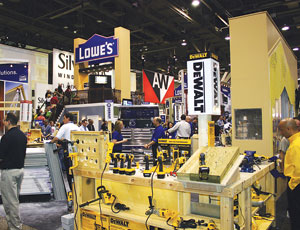The best word to describe the mood at the National Association of Home Builders’ International Builders Show and the current homebuilding market is “grim.” About 60,000 people attended the show in Las Vegas on Jan. 20-23, 40% fewer than attended the show last year. Exhibitors said they were not surprised at the attendance, given the state of the economy and market. Kohler, the plumbing and fixture giant, said foot traffic was off by at least 20%. “There have been more questions about how we are doing as a company than questions about our new products,” said one Kohler rep.

There were noticeable gaps in the displays, and many large tool manufacturers did not have their traditional large booths, choosing to tag along with Lowes and Home Depot in a co-op arrangement. “It is the only place they were selling tools before,” and they save money, said one Lowes representative.
Two bright spots in the market are that the demographics ahead are very good for new-home construction and mortgage interest rates are the lowest in 50 years for purchasers with a downpayment, good credit history, full documentation and a conforming loan balance.
Borrowers need all four, otherwise the interest rates will be “much, much more,” said Frank Nothaft, chief economist for Freddie Mac, Washington, D.C. He said lenders “are tightening the loan box” for single-family homes, multi-unit residential properties and construction loans as foreclosures and defaults mount and house and apartment prices decline.
There currently is an imbalance of supply and demand, with more than 1.5 million houses for rent or sale standing empty, said NAHB’s new chief economist, David Crowe. He noted that less than one-third are new, but he pointed out that there is “a constant supply of homes in foreclosure” coming into the market, “in excess of 2 million per year,” and “builders are not building anything.” Crowe said the 400,000 vacant new units ordinarily would not be considered a glut, but “no one is buying.”
David Berson, chief economist for mortgage insurer PMI Group Inc., Walnut Creek, Calif., expects it will be two or three years before the housing market stabilizes. He predicts starts for single-family homes will total 620,000 units this year and multiunit housing 280,000 units, for a total of 925,000 including manufactured housing. He predicts 1.5 million to 1.9 million starts after the market stabilizes, mostly because of high rates of family formation, which will total 1.4 million this year. “Ultimately, we will get through this period,” he said.
“We are losing members,” noted NAHB’s Crowe. “We probably have lost 15% to 20% over the past year, [and] we will lose more....Some will do something else, combine with competitors or just disappear.” Crowe said NAHB estimates it has lost 3 million jobs in residential construction.
David Ledford, an NAHB senior staff vice president, said builders whose financial institutions have been taken over by the Federal Deposit Insurance Corp. are having their projects put into receivership even if they are viable projects. FDIC does not want to be in the lending business, he said.
Homebuilders report increasing frequency of “drive-by appraisals” and that recent closings are not accepted by financial institutions. Some builders in NAHB’s 50+ Housing Council said banks are not accepting closing prices as fresh as two months old and are using foreclosure, short-sell and deeply discounted prices. “It is self-feeding,” added Christine Fortenberry, CEO of Fortenberry Construction, Powder Springs, Ga.
“We continue to advocate for an economic-stimulus package that recognizes how important the homebuilding industry is to helping the nation get back on track, and when it does, we will be ready,” said NAHB Chairman Joe Robson, a Tulsa homebuilder. “We’re in the midst of an industry crisis.” NAHB is supporting Fix Housing First legislation.

Post a comment to this article
Report Abusive Comment